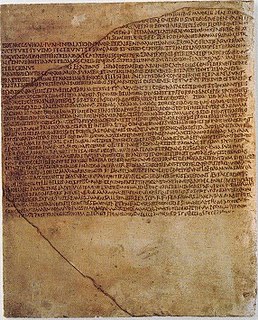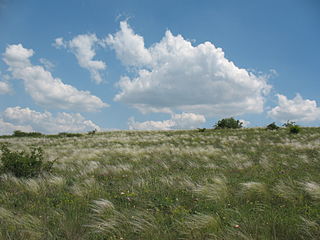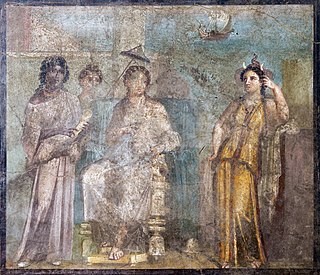
Athena or Athene, often given the epithet Pallas, is an ancient Greek goddess associated with wisdom, warfare, and handicraft who was later syncretized with the Roman goddess Minerva. Athena was regarded as the patron and protectress of various cities across Greece, particularly the city of Athens, from which she most likely received her name. The Parthenon on the Acropolis of Athens is dedicated to her. Her major symbols include owls, olive trees, snakes, and the Gorgoneion. In art, she is generally depicted wearing a helmet and holding a spear.

In ancient Greek mythology and religion, Eos is the goddess and personification of the dawn, who rose each morning from her home at the edge of the river Oceanus to deliver light and disperse the night. In Greek tradition and poetry she is characterized as a goddess with a great sexual appetite, who took numerous lovers for her own satisfaction and bore them several children. Like her Roman counterpart Aurora and Rigvedic Ushas, Eos continues the name of an earlier Indo-European dawn goddess, Hausos. Eos, or her earlier Proto-Indo-European (PIE) ancestor, also shares several elements with the love goddess Aphrodite, perhaps signifying Eos's influence on her or otherwise a common origin for the two goddesses. In surviving tradition, Aphrodite is the culprit behind Eos' numerous love affairs, having cursed the goddess with insatiable lust for mortal men.

Venus is a Roman goddess, whose functions encompass love, beauty, desire, sex, fertility, prosperity, and victory. In Roman mythology, she was the ancestor of the Roman people through her son, Aeneas, who survived the fall of Troy and fled to Italy. Julius Caesar claimed her as his ancestor. Venus was central to many religious festivals, and was revered in Roman religion under numerous cult titles.

In ancient Roman religion, Ceres was a goddess of agriculture, grain crops, fertility and motherly relationships. She was originally the central deity in Rome's so-called plebeian or Aventine Triad, then was paired with her daughter Proserpina in what Romans described as "the Greek rites of Ceres". Her seven-day April festival of Cerealia included the popular Ludi Ceriales. She was also honoured in the May lustratio of the fields at the Ambarvalia festival, at harvest-time, and during Roman marriages and funeral rites. She is usually depicted as a mature woman.

Acca Larentia or Acca Larentina was a mythical woman, later goddess of fertility, in Roman mythology whose festival, the Larentalia, was celebrated on December 23.

Bona Dea was a goddess in ancient Roman religion. She was associated with chastity and fertility in Roman women, healing, and the protection of the state and people of Rome. According to Roman literary sources, she was brought from Magna Graecia at some time during the early or middle Republic, and was given her own state cult on the Aventine Hill.

In Roman mythology and religion, Quirinus is an early god of the Roman state. In Augustan Rome, Quirinus was also an epithet of Janus, as Janus Quirinus.

In ancient Roman religion, Roma was a female deity who personified the city of Rome and more broadly, the Roman state. She was created and promoted to represent and propagate certain of Rome's ideas about itself, and to justify its rule. She was portrayed on coins, sculptures, architectural designs, and at official games and festivals. Images of Roma had elements in common with other goddesses, such as Rome's Minerva, her Greek equivalent Athena and various manifestations of Greek Tyches, who protected Greek city-states; among these, Roma stands dominant, over piled weapons that represent her conquests, and promising protection to the obedient. Her "Amazonian" iconography shows her "manly virtue" (virtus) as fierce mother of a warrior race, augmenting rather than replacing local goddesses. On some coinage of the Roman Imperial era, she is shown as a serene advisor, partner and protector of ruling emperors. In Rome, the Emperor Hadrian built and dedicated a gigantic temple to her as Roma Aeterna, and to Venus Felix,, emphasising the sacred, universal and eternal nature of the empire.

Ambarvalia was a Roman agricultural fertility rite held on 29 May in honor of Ceres and Dea Dia.

The Carmen Arvale is the preserved chant of the Arval priests or Fratres Arvales of ancient Rome.

The Floralia was a festival in ancient Roman religious practice in honor of the goddess Flora, held April 27 during the Republican era, or April 28 in the Julian calendar. The festival included Ludi Florae, the "Games of Flora", which lasted for six days under the empire.

In ancient Roman religion, the Arval Brethren or Arval Brothers were a body of priests who offered annual sacrifices to the Lares and gods to guarantee good harvests. Inscriptions provide evidence of their oaths, rituals and sacrifices.

In ancient Roman religion and mythology, Tellus Mater or Terra Mater is the personification of the Earth. Although Tellus and Terra are hardly distinguishable during the Imperial era, Tellus was the name of the original earth goddess in the religious practices of the Republic or earlier. The scholar Varro (1st century BC) lists Tellus as one of the di selecti, the twenty principal gods of Rome, and one of the twelve agricultural deities. She is regularly associated with Ceres in rituals pertaining to the earth and agricultural fertility.

*Dyḗus, also *Dyḗus ph₂tḗr, is the reconstructed name of the daylight-sky god in Proto-Indo-European mythology. *Dyēus was conceived as a divine personification of the bright sky of the day and the seat of the gods, the *deywṓs. Associated with the vast diurnal sky and with the fertile rains, *Dyēus was often paired with *Dʰéǵʰōm, the Earth Mother, in a relationship of union and contrast.
The Acta Arvalia were the recorded protocols of the Arval Brothers (Arvales fratres), a priestly brotherhood (sodalitas) of ancient Roman religion.

In ancient Roman culture, the olla is a squat, rounded pot or jar. An olla would be used primarily to cook or store food, hence the word “olla" is still used in some Romance languages for either a cooking pot or a dish in the sense of cuisine. In the typology of ancient Roman pottery, the olla is a vessel distinguished by its rounded “belly,” typically with no or small handles or at times with volutes at the lip, and made within a Roman sphere of influence; the term olla may also be used for Etruscan and Gallic examples, or Greek pottery found in an Italian setting.

The Mother of the Lares has been identified with any of several minor Roman deities. She appears twice in the records of the Arval Brethren as Mater Larum, elsewhere as Mania and Larunda. Ovid calls her Lara, Muta and Tacita.

Goddess Africa, also known as Dea Africa, was the personification of Africa by the Romans in the early centuries of the common era. She was one of the fertility and abundance deities to some. Her iconography typically included an elephant-mask head dress, a cornucopia, a military standard, and a lion.
Tiberius Julius Candidus Marius Celsus was a Roman senator who lived during the Flavian dynasty. Contemporary sources, such as the Fasti Ostienses, the Acta Arvalia and a letter of Pliny the Younger, refer to him as Tiberius Julius Candidus. He was twice consul.

















